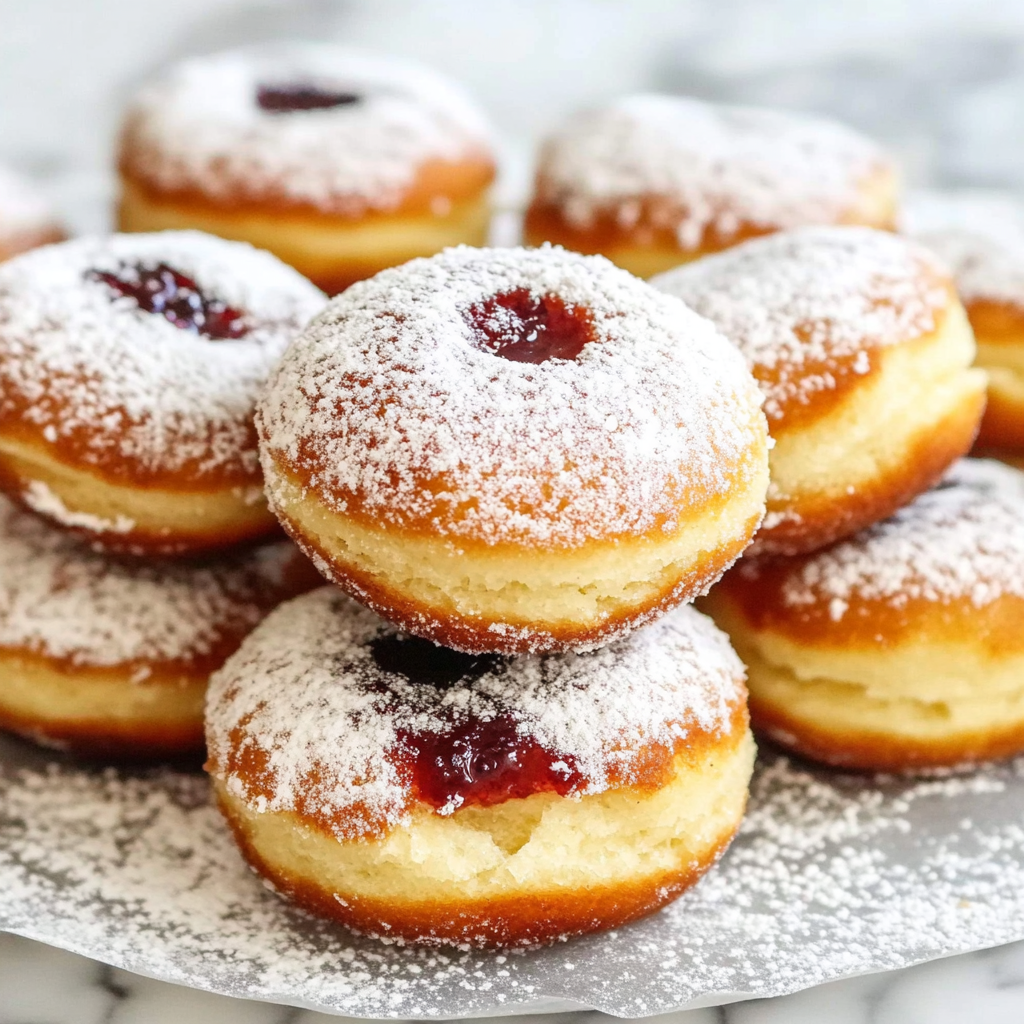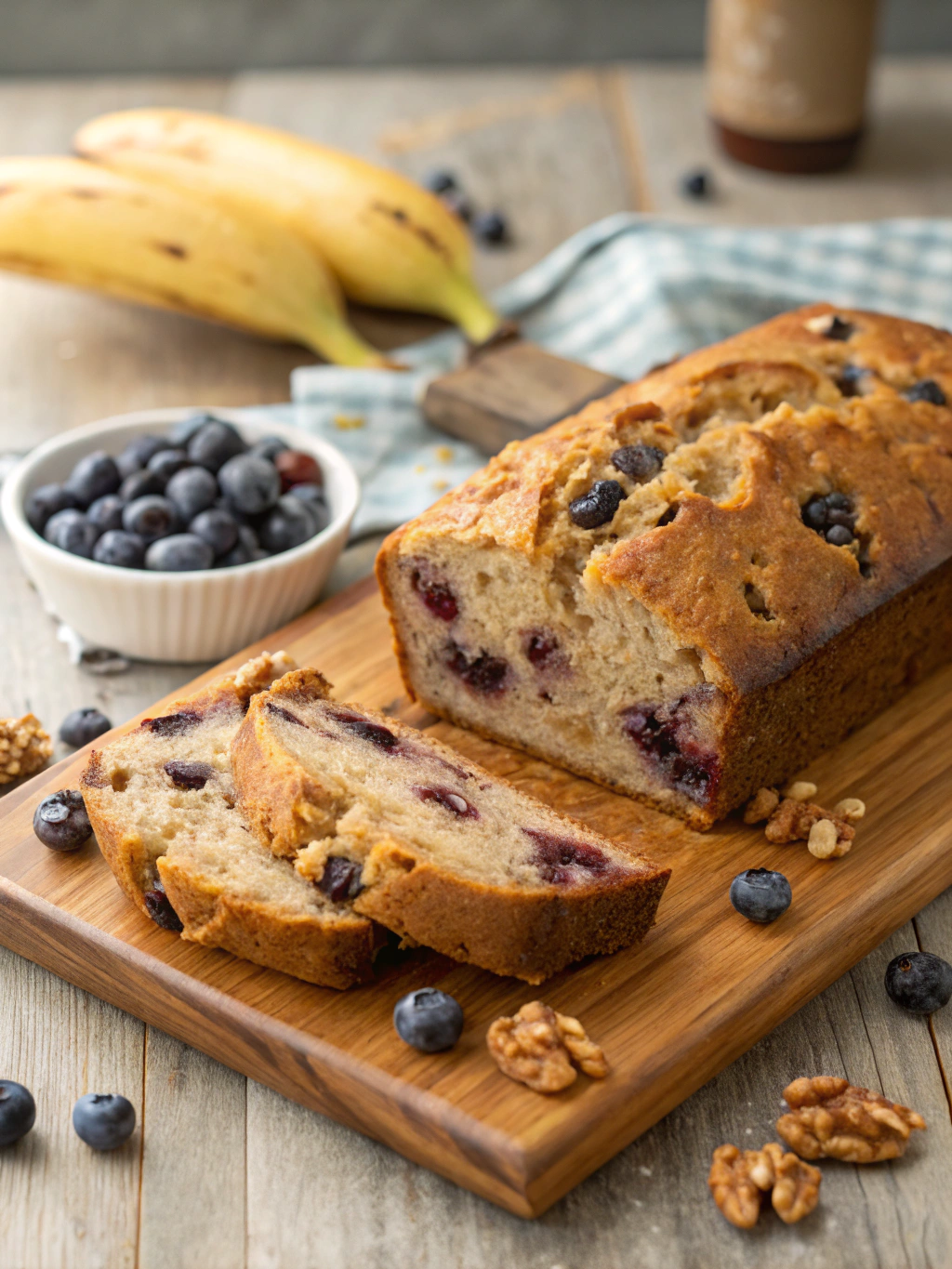Sharing is caring!
Paczki Recipe
Why You’ll Love Paczki?
Paczki, the beloved Polish donuts, are a delightful treat that brings a burst of joy to any occasion. These fluffy, deep-fried pastries are traditionally enjoyed on Fat Tuesday but are delicious year-round. What makes paczki special is their rich, slightly sweet dough and luscious fillings—think raspberry jam, custard, or even chocolate. Whether you’re celebrating a holiday or simply craving something indulgent, this easy-to-follow recipe ensures you can whip up a batch in no time. Perfect for sharing or savoring solo, paczki are a must-try for any dessert lover!
Table of Contents
Ingredients to make paczki?
- 4 cups all-purpose flour
- 1/2 cup granulated sugar
- 2 large eggs
- 1 cup warm milk
- 1/4 cup unsalted butter, melted
- 1 packet (2 1/4 tsp) active dry yeast
- 1 tsp salt
- 1 tsp vanilla extract
- Zest of 1 lemon (optional)
- Vegetable oil (for frying)
- 1/2 cup fruit jam or custard (for filling)
- Powdered sugar (for dusting)
Time needed to make paczki?
Making paczki doesn’t have to take all day! With the right steps, you can enjoy these fluffy Polish donuts in just 30 minutes. Here’s a quick breakdown:
- Prep Time: 15 minutes (mixing dough, letting it rest)
- Cook Time: 10 minutes (frying to golden perfection)
- Total Time: 25–30 minutes
For a faster alternative, try this quick dough method to cut down on prep. Want more time-saving tips? Check out our guide to speedy dessert hacks for busy bakers!
Quick Steps to Make Paczki?
Step 1: Prepare the Dough
Combine warm milk, yeast, and a pinch of sugar in a bowl. Let it sit for 5 minutes until frothy. In a large mixing bowl, whisk together flour, sugar, salt, and egg yolks. Gradually add the yeast mixture and melted butter, kneading until smooth.
Step 2: Let the Dough Rise
Cover the dough with a damp cloth and let it rise in a warm place for about 1 hour or until doubled in size. This ensures your paczki will be light and fluffy.
Step 3: Shape the Paczki
Punch down the dough and roll it out to about ½-inch thickness. Use a round cutter (or a glass) to shape the dough into circles. Place them on a floured tray and let them rise again for 30 minutes.
Step 4: Fry to Golden Perfection
Heat oil in a deep pan to 350°F (175°C). Carefully fry the paczki in batches, turning once, until golden brown on both sides—about 2-3 minutes per side. Drain on paper towels.
Step 5: Fill and Dust
Once cooled slightly, fill the paczki with jam or custard using a piping bag. Dust generously with powdered sugar or glaze for a classic finish. Serve warm for the best taste!
Is paczki healthy and nutritious ?
Paczki, the beloved Polish donuts, are undeniably delicious but not exactly a health food. A single paczki can contain around 300–400 calories, with most coming from refined carbs and fats. However, they do provide small amounts of iron and B vitamins from the enriched flour. For a lighter version, try baking instead of frying or using whole wheat flour for added fiber. If you’re craving dessert but want something more balanced, check out this pumpkin apple bread for a healthier treat. Alternatively, explore vegetarian enchiladas for a nutrient-packed meal. For more insights on balancing indulgence, slow cooker recipes can offer wholesome alternatives. If you love sweets but need lower-calorie options, pumpkin cheesecake is a great choice.
Can I make paczki healthier and still delicious?
Absolutely! While traditional paczki are indulgent, you can tweak the recipe to make it lighter without sacrificing flavor. Here are some smart swaps to try:
Healthier Ingredient Alternatives
- Use whole wheat pastry flour or almond flour instead of all-purpose flour for extra fiber and nutrients.
- Replace some of the butter with unsweetened applesauce or mashed banana to reduce saturated fat.
- Try baking instead of deep-frying for a lighter version – check out this guide to healthier baking techniques.
Lighter Filling Options
- Opt for sugar-free fruit preserves or make your own using fresh berries.
- Try a protein-rich Greek yogurt filling instead of custard.
- Dust with powdered erythritol instead of regular powdered sugar.
For more inspiration on healthier desserts, explore these guilt-free cookie recipes that use similar techniques. And if you’re looking for other Polish-inspired treats with a healthy twist, our roasted chicken recipe uses traditional spices in a nutritious way.
Remember, even small changes can make paczki more nutritious while keeping them delicious. The key is balancing health with authentic flavor!
How to Serve Paczki?
Paczki are best enjoyed fresh and warm, ideally right after frying. Dust them generously with powdered sugar or roll them in granulated sugar for that classic finish. For an extra touch, drizzle with a simple glaze made from powdered sugar and milk or fill them with fruit preserves like raspberry or apricot.
Pair these Polish donuts with a cup of strong coffee or hot chocolate for a cozy breakfast or dessert. If you’re serving them for a special occasion, consider offering a variety of fillings—custard, chocolate, or even vanilla bean whipped cream for a decadent twist. For a festive spread, include other European pastries like savory bites to balance the sweetness.
If you’re hosting a brunch, serve paczki alongside fresh fruit or a light seasonal soup to contrast the richness. For a fun twist, set up a DIY topping bar with sprinkles, Nutella, or peanut butter drizzle so guests can customize their treats.
Avoid These Mistakes
Making paczki can be tricky, but avoiding these common errors ensures perfect results every time.
Overproofing the Dough
Letting the dough rise too long leads to dense, greasy paczki. Stick to the recommended proofing time in our easy dough guide for light, airy texture.
Wrong Oil Temperature
Frying at incorrect temperatures causes uneven cooking. Use a candy thermometer to maintain 350-375°F, as demonstrated in this frying temperature guide.
Overfilling with Jam
Too much filling causes messy leaks. For perfect portioning, check our filling techniques or this professional piping tutorial.
Skipping the Sugar Coating
The sugar coating isn’t just decorative – it absorbs excess oil. Learn proper dusting methods from our finishing techniques guide.
The best way to store leftover paczki
Freshly made paczki taste best the same day, but if you have leftovers, proper storage keeps them delicious for longer. Here’s how:
Room Temperature Storage
Place cooled paczki in an airtight container or resealable bag with a paper towel to absorb excess moisture. They’ll stay fresh for 1–2 days. For longer shelf life, try freezing them—just like how you’d store other fried treats.
Freezing for Longevity
Wrap each paczek individually in plastic wrap, then place them in a freezer-safe bag. They’ll keep for up to 2 months. Thaw at room temperature or gently reheat in the oven for 5–7 minutes at 300°F (150°C). For more tips on preserving baked goods, check out this guide.
Reheating Tips
Avoid microwaving—it makes them soggy. Instead, warm paczki in a 325°F (160°C) oven for 5 minutes or until crisp. Pair reheated leftovers with a savory dish to balance the sweetness, or enjoy them with coffee as the Polish do. For more dessert storage hacks, this resource has great insights.
Ready to give paczki a try?
These irresistible Polish donuts are easier to make than you think, delivering a perfect balance of fluffy dough and sweet fillings in just 30 minutes. Whether you’re celebrating Fat Tuesday or simply craving a decadent treat, paczki won’t disappoint. For more comforting recipes, check out our creamy garlic chicken or vegetarian enchiladas. If you love baked goods, explore our roasted chicken drumsticks for a savory twist or dive into easy chicken breast recipes for quick weeknight meals. Happy baking!
Frequently Asked Questions
What are paczki?
Paczki are traditional Polish donuts, deep-fried and filled with sweet fillings like jam or custard. They’re especially popular during Fat Tuesday celebrations.
Can I bake paczki instead of frying them?
While traditional paczki are fried, you can bake them for a lighter version. However, the texture won’t be as authentic.
How long do paczki stay fresh?
Paczki are best eaten the same day but can last up to 2 days if stored properly in an airtight container.
What’s the best filling for paczki?
Popular fillings include raspberry jam, custard, or prune. Feel free to experiment with your favorite flavors!
Can I make paczki gluten-free?
Yes! Substitute regular flour with a gluten-free blend, though the texture may vary slightly.











